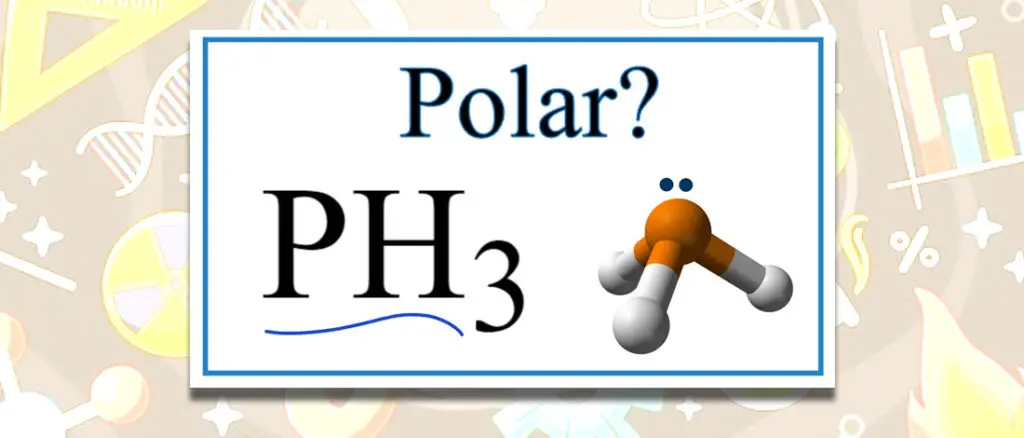PH3 is one of the most confusing chemical compounds in Chemistry because of its polarity that can be polar and nonpolar. The Phosphine or Phosphorus Trihydride is a toxic flammable gas that smells like rotten fish.
Is PH3 polar or Nonpolar?
Let’s dive deeper as our team spent 24 hours of intensive research to clear things out.
Contents
Polarity or Nonpolarity of Phosphorus Trihydrate
Phosphorus Trihydrate is a polar molecule since it has a lone electron with electron-electron repulsion that results in a bent structure. The Phosphorus atom and Hydrogen atom bond is nonpolar because of the same electronegativity; however, Phosphorus has an unshared pair of electrons.
In addition, PH3 is considered polar because the chemical compound has three Hydrogen atoms and five valence electrons. The Octet Rule is completed because of the three electrons on the Phosphorus. The P atom will have a remaining lone pair of electrons (two valence electrons) at the pure P orbitals and results in a negative region. The three Hydrogen bonds will be positive, and by this, the molecule will produce positive region and negative region.

Name of Molecule | Phosphine |
Molecular Mass | 33.99758 g/mol |
Dipole Moment | 0.58D |
Bond Angle | 93 degrees |
Hybridization | Nil |
Molecular Geometry/Shape | Trigonal Pyramidal |
Molecular Formation & Structure
In identifying the structure and formation of the Phosphorus Trihydrate, you should draw a Lewis Structure. A Lewis structure is a simplified representation of valence shell electrons of a compound molecule [1].
The two atoms do not belong to the same group within the periodic table, and with this, the PH3 has three Hydrogen and five valence electrons in its atom. The central atom belongs to Phosphorus, and the three Hydrogens have one lone pair of electrons. The molecular geometry has asymmetrical charge distribution because one lone pair orbital avoids PH3 from being hybridized.

What Determines PF3 Polarity

PH3 Geometric Shape
Lewis Structure determines the PH3 geometric shape. Since the PH3 has a lone pair out of three bond pairs, its geometrical shape will be trigonal pyramidal. P is the central atom, and since there is one lone pair, the net charge will not be canceled and it will produce an asymmetrical geometric structure.
Since the geometric shape of the Phosphorus Trihydrate is asymmetric, it is safe to say that PH3 is a polar molecule.
PH3 Electronegativity
Phosphine is a well-qualified polar molecule with nonpolar covalent bonds. The Hydrogen atoms and Phosphorus atoms have almost the same electronegative property based on the periodic table, which means the covalent bonds are nonpolar.
However, PH3 is polar because all the polar molecules contain polar covalent bonds formed due to electronegativity values found between the bonded atoms.
Related Posts:
PH3 Dipole Moment
When the molecule unequally shares electrons, it creates a bond, and a dipole moment will be created. Dipole moments are equally proportional to the molecule’s electronegativity. The larger electronegativity difference makes a larger dipole moment.
The dipole moment for PH3 is 0.58D, and since the dipole moment is not equal to zero, PH3 is polar.
Commercial Uses of PH3
PH3 is a colorless gas that has a putrid smell, and it is flammable due to the substituted Phosphine and Diphosphate. PH3 is used commercially in different industries because of its properties
Phosphine is widely used as a semiconductor to institute Phosphorus to silicon crystals. In plastic industries, PH3 is used as a polymerization initiator. Since the PH3 has flammable properties, it is also used as flame retardants, and an essential ingredient in manufacturing LED lights. In addition, PH3 can also be used in the processing of chemicals like pesticides in storing grains, tobacco, and other food products.
FAQs
PH3 is basic. Based on the Lewis structure, the basic donate pairs of valence electrons while the acidic accepts it. Since PH3 has lone pairs of electrons that can be donated, the compound is basic.
PH3 is a polar molecule based on our research. The geometric structure of PH3 is asymmetric because it has an uneven charge distribution (lone pair) and an unbonded pair of valence electrons, which makes the whole molecule polar. In addition, the chemical formula produces electronegativity difference and dipole moment, which makes it a polar molecule.
PH3 is created by combining any strong base and hot boiling water. Since the boiling point for PH3 is at -87.7 °C and the melting point is at -132.8, white Phosphorus is more soluble in water. In addition, water with calcium phosphide creates chemical reactions on the PH3.
Is PH3 Polar or Nonpolar?
Many people are confused with the polarity properties of PH3, but this article proved that PH3 is polar. Based on the Lewis structure, the molecular geometry of the chemical compound is proven trigonal pyramidal. And since the PH3 almost has the same electronegativity and strong dipole moment, the chemical compound is polar.
Now that the polarity and properties of PH3 have been cleared out, you can now have the confidence to use the chemical compound. It can be dangerous because of its nature; however, it is widely used commercially since the compound is soluble in nonpolar solutions.
Thank you for reading this far! I hope that the information provided in this article will be helpful to you.
References:
- https://chem.libretexts.org/Bookshelves/Physical_and_Theoretical_Chemistry_Textbook_Maps/Supplemental_Modules_(Physical_and_Theoretical_Chemistry)/Physical_Properties_of_Matter/Atomic_and_Molecular_Properties/Lewis_Structures
- 8 Best Books On Evolution (2023 Updated) - May 16, 2022
- How Could Natural Selection Lead To Evolution? (2023) - May 16, 2022
- How Do Fossils Provide Evidence For Evolution? (2023) - May 16, 2022

